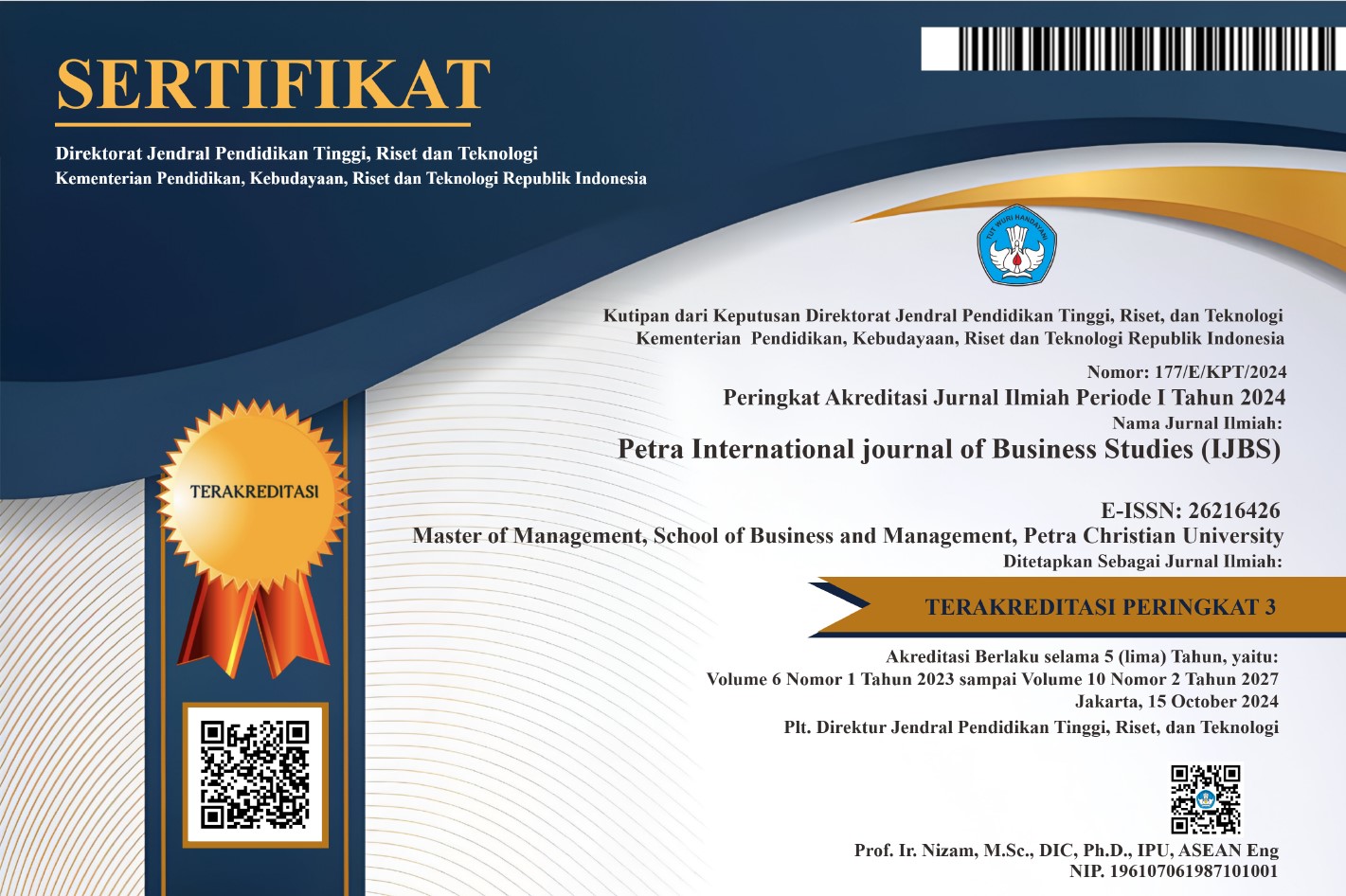The Analysis of Online Brand Community, Online Perceived Brand Reputation, Brand Trust, Brand Loyalty at Cafe Businesses Based in Surabaya
DOI:
https://doi.org/10.9744/ijbs.1.1.11-22Keywords:
Online Brand Community, Online Perceived Brand Reputation, Brand Trust, Brand Loyalty, Social Media MarketingAbstract
The internet has become a human lifestyle. Many business people took advantage of this opportunity to market their business by using social media marketing strategy on Facebook or Instagram. Activities in the online brand community on social media platforms could build consumer perceptions of a brand inside the online world and would form a belief in the brand that ultimate to loyalty. Therefore, social media marketing must be known for its effectiveness. This study aims to determine the influence of the online brand community on online perceived brand reputation, brand trust, and brand loyalty at cafes in Surabaya. The method used in this study is quantitative by spreading the questionnaires to 240 respondents of college students both online and offline. The research using purposive sampling technique and the sample used in this research is the consumers of De Mandailing Cafe & Eatery, Panties Pizza, and Warunk Upnormal in Surabaya where the three cafes are considered to represent the whole cafes with the same quality, consumers, service system, and price range. From the results of this study, it can be concluded that online brand community has a significant impact on brand loyalty through online process perceived brand reputation and brand trust.
Downloads
References
Association of Cafe and Restaurant Entrepreneurs Indonesia. (2011). The Development of Food and Beverage Industry. Bappeda Jatim. Retrieved from: http://bappeda.jatimprov.go.id
Association of Indonesian Internet Service Providers. (2016). Internet users in Indonesia by region. Retrieved from https://apjii.or.id/.
Ba, S., & Pavlou, P. A. (2002). Evidence of the Effect of Trust Building Technology in Electronic Markets: Price Premiums and Buyer Behavior. MIS Quarterly, 26(3), 243–268. https://doi.org/10.2307/4132332
Bagozzi, R. P., & Dholakia, U. M. (2002). International Social Actions in Virtual Communities. Journal of Interactive Marketing (John Wiley & Sons), 16(2), 2–21. https://doi.org/10.1002/dir.10006
Brogi, S. (2014). Online Brand Communities: A Literature Review. Procedia - Social and Behavioral Sciences, 109(0), 385–389. https://doi.org/http://dx.doi.org/10.1016/j.sbspro.2013.12.477
Brogi, S., Calabrese, A., Campisi, D., Capece, G., Costa, R., & Di Pillo, F. (2013). The effects of online brand communities on brand equity in the luxury fashion industry. International Journal of Engineering Business Management, 5(SPL.ISSUE). https://doi.org/10.5772/56854
Coffman, K. G., & Odlyzko, A. M. (2001). Internet growth: Is there a “Moore’s Law” for data traffic? Handbook of Massive Data Sets. In Handbook of Massive Data Sets.
Davies, G., Chun, R., Vinhas da Silva, R., & Roper, S. (2003). Corporate reputation and competitiveness. Corporate Reputation Review (Vol. 5). https://doi.org/10.1057/palgrave.crr.1540185
de Valck, K., van Bruggen, G. H., & Wierenga, B. (2009). Virtual communities: A marketing perspective. Decision Support Systems, 47(3), 185–203. https://doi.org/10.1016/j.dss.2009.02.008
Delgado-Ballester, E. (2003). Development and validation of a brand trust scale. International Journal of Market Research, 45(1), 35–54. https://doi.org/10.1088/1751-8113/44/8/085201
Delgado-Ballester, E., & Luis Munuera-Alemán, J. (2001). Brand trust in the context of consumer loyalty. European Journal of Marketing, 35(11/12), 1238–1258. https://doi.org/10.1108/EUM0000000006475
Delgado-Ballester, & Munuera-Alemán, E. J. L. (2005). Does brand trust matter to brand equity? Journal of Product & Brand Managemen, 14(3).
Geisser, S. (1974). A predictive approach to the random effect model. Biometrika, 61(1), 101–107. https://doi.org/10.1093/biomet/61.1.101
Ha, H. (2004). Factors influencing consumer perceptions of brand trust online. Journal of Product & Brand Management, 13(5), 329–342. https://doi.org/10.1108/10610420410554412
Hair, J. F., Black, W. C., Babin, B. J., & Anderson, R. E. (2006). Multivariate Data Analysis (6th ed.). Analysis, 4–4.
Hair, J. F., Black, W. C., Babin, B. J., & Anderson, R. E. (2010). Multivariate Data Analysis. Vectors. https://doi.org/10.1016/j.ijpharm.2011.02.019
Hair, J. F. J., Hult, G. T. M., Ringle, C., Sarstedt, M., Hair Jr, J. F., Hult, G. T. M., Sarstedt, M. (2013). A primer on partial least squares structural equation modeling (PLS-SEM). Long Range Planning (Vol. 46). https://doi.org/10.1016/j.lrp.2013.01.002
Hayoz, M. (2016). The influence of online brand community on brand loyalty and the role of brand commitment. University of Fribourg Faculty of Economics and Social Sciences Department of Economics.
Hollebeek, L. D. (2011). Demystifying customer brand engagement: Exploring the loyalty nexus. Journal of Marketing Management, 27(7–8), 785–807. https://doi.org/10.1080/0267257X.2010.500132
Idrees, Z., Xinping, X., Shafi, K., Hua, L., & Nazeer, A. (2015). Consumer’s Brand Trust and Its Link to Brand Loyalty. American Journal of Business, Economics and Management, 3(2), 34.
Kaufmann, H. R., Loureiro, S. M. C., & Manarioti, A. (2016). Exploring behavioural branding, brand love and brand co-creation. Journal of Product & Brand Management, 25(6), 516–526.
Kim, A. J., & Ko, E. (2010). Impacts of Luxury Fashion Brand’s Social Media Marketing on Customer Relationship and Purchase Intention. Journal of Global Fashion Marketing, 1(3), 164–171. https://doi.org/10.1080/20932685.2010.10593068
Laroche, M., Habibi, M. R., & Richard, M. O. (2013). To be or not to be in social media: How brand loyalty is affected by social media? International Journal of Information Management, 33(1), 76–82. https://doi.org/10.1016/j.ijinfomgt.2012.07.003
Madrigal. (2012). Dark Social: We Have the Whole History of the Web Wrong. The Atlantic. Retrieved from: http://neoscenes.net/teach/cu/2013_1/atls2000_mit/pdfs/Madrigal- 2012-Dark_Social.pdf
Muniz, Jr., A. M., & O’Guinn, T. C. (2001). Brand Community. Journal of Consumer Research, 27(4), 412–432. https://doi.org/10.1086/319618
Reicheld, F. F., Markey, R. G., & Hopton, C. (2000). E-customer loyalty - applying the traditional rules of business for online success. European Business Journal, 16(2), 173–179.
Schiffman, L., & Kanuk, L. (2009). Consumer Behavior. New Jersey: Perason Prestice Hall.
Stone, M. (1974). Cross-Validatory Choice and Assessment of Statistical Predictions. Journal of the Royal Statistical Society, 36(2), 111–147. https://doi.org/10.2307/2984809
Wang, H., & Hu, Z. (2009). Online trust between inexperienced consumers and experienced consumers: An empirical study. In 2009 2nd International Conference on Future Information Technology and Management Engineering, FITME 2009 (pp. 167–170). https://doi.org/10.1109/FITME.2009.47
Zeithaml, V. a. (2000). Service Quality, Profitability, and the Economic Worth of Customers: What We Know and What We Need to Learn. Journal of the Academy of Marketing Science, 28(1), 67–85. https://doi.org/10.1177/0092070300281007
Additional Files
Published
Issue
Section
License
Petra IJBS (e-ISSN: 2621-6426) is published by Master of Management program, School of Business and Management, Petra Christian University, Indonesia (MM SBM PCU).












